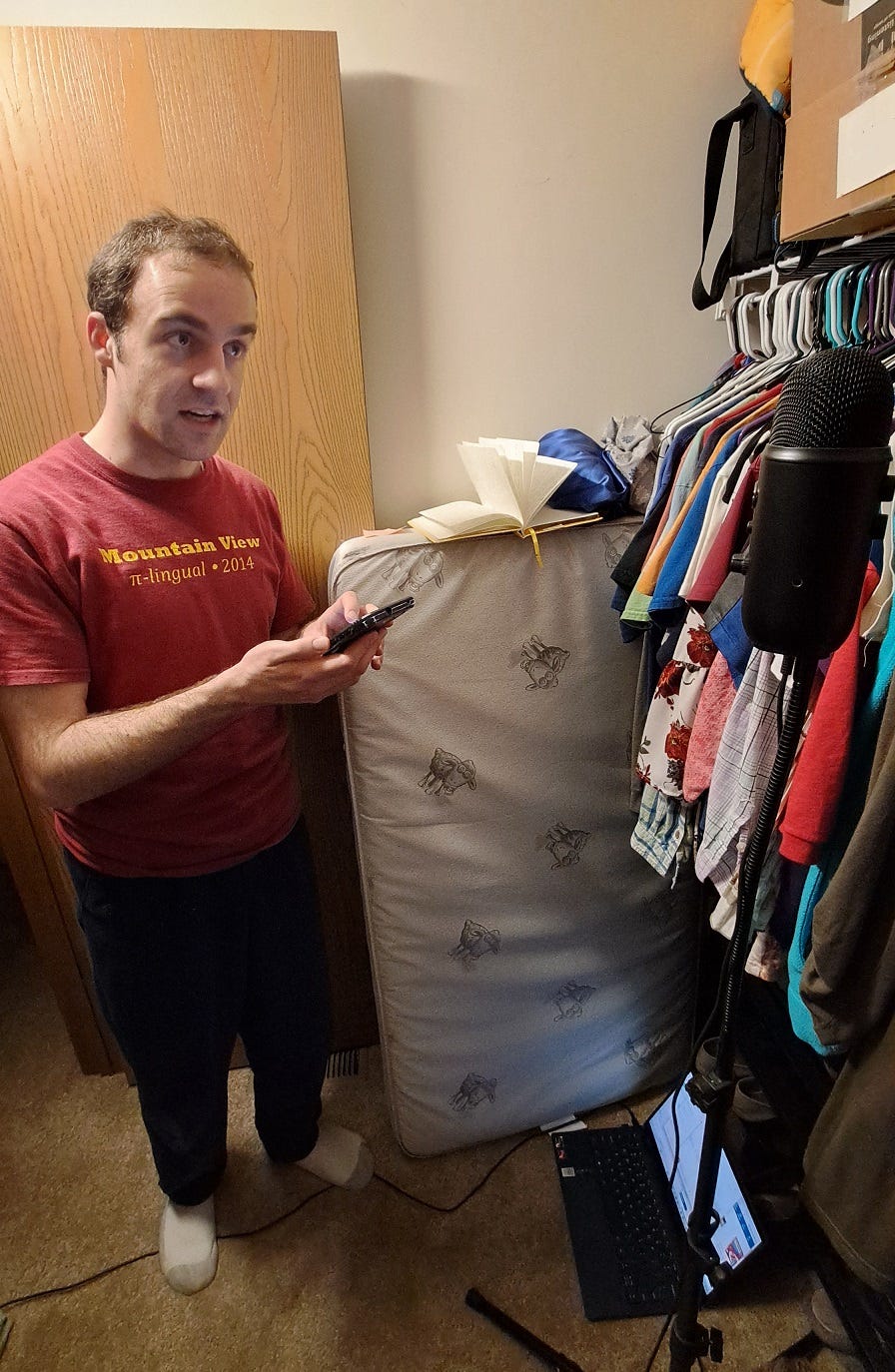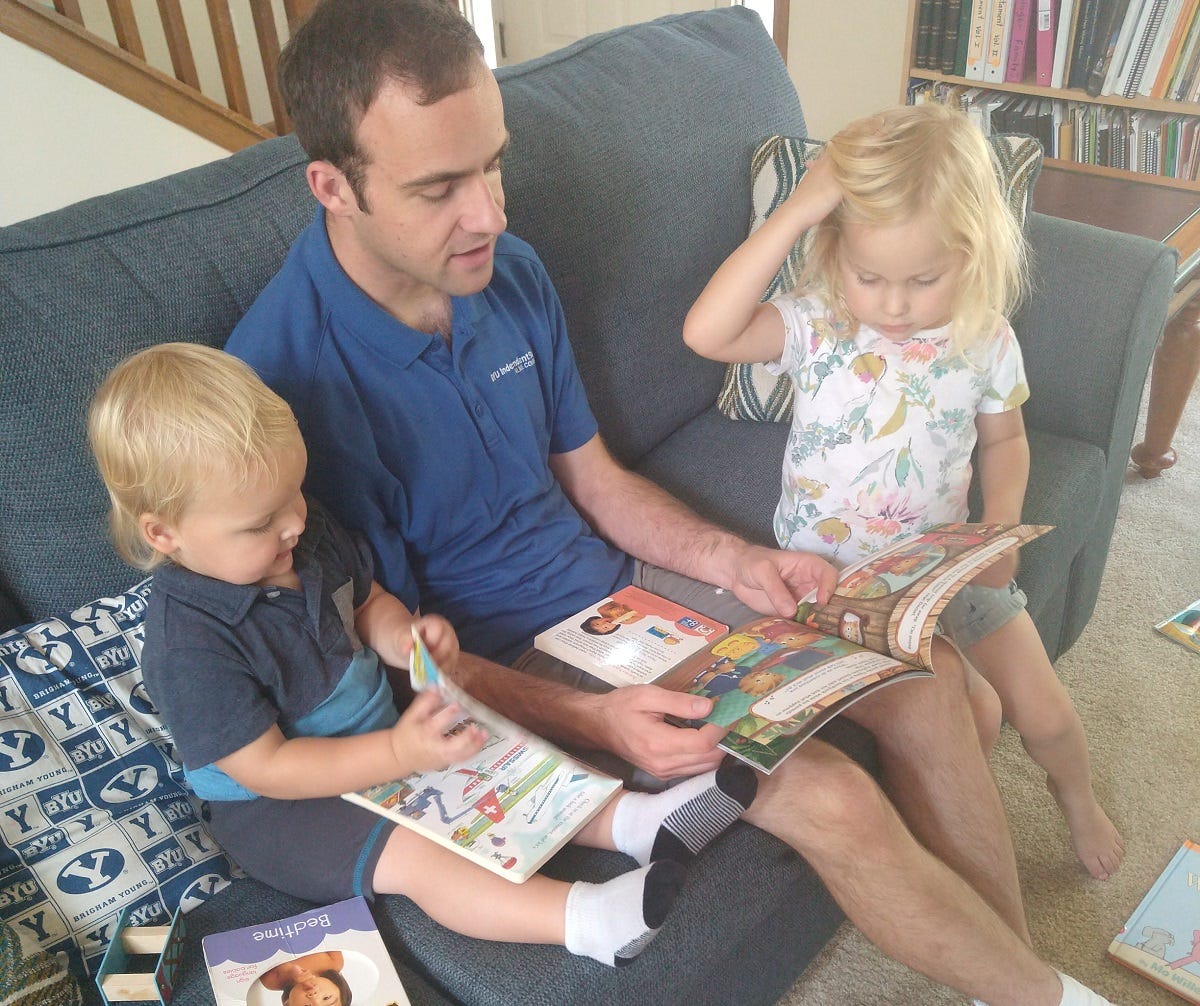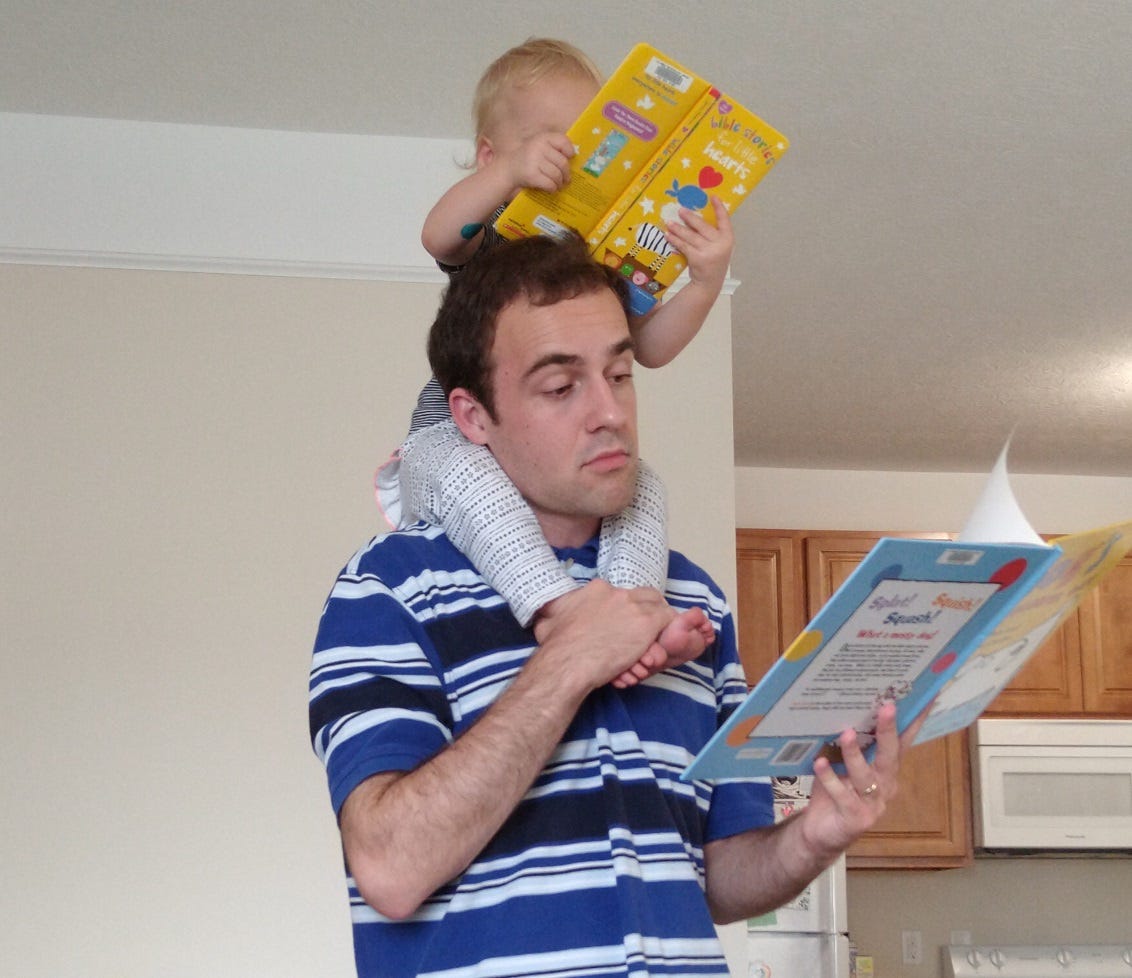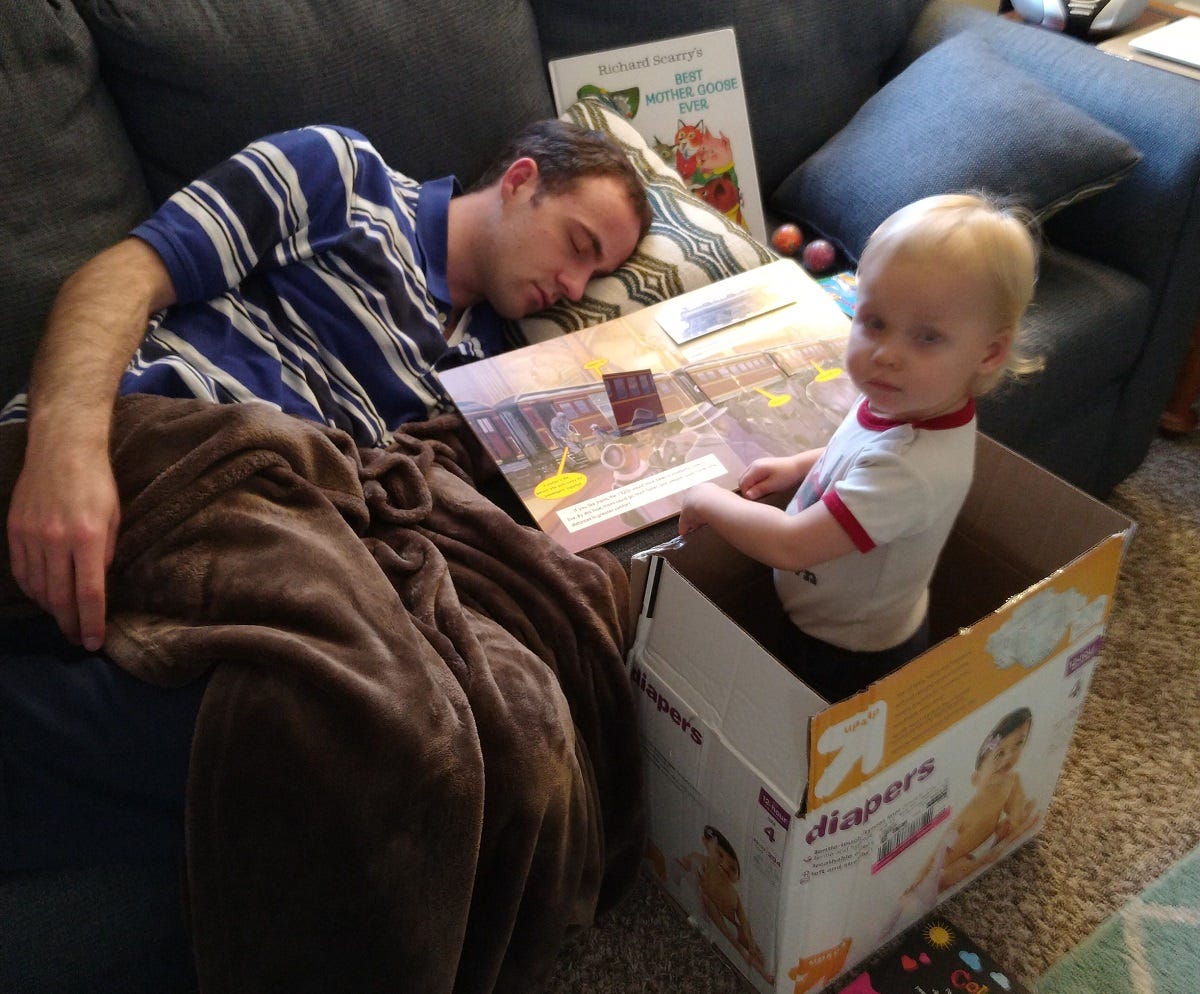The audiobook for The Pyromancer’s Scroll is now complete and available for sale!
I’ve gotten lots of questions on the process of producing and narrating my own audiobook, so here are some FAQs:
How long is the audiobook?
18 hours and 16 minutes!
At 169,000 words, this represents 154 words per minute—smack dab in the middle of the average narration speed of 150–160 words per minute. (This surprised me, because I thought my narration tended toward the fast side.)
What was your recording studio setup?
My closet. Literally.
There’s all sorts of fancy and detailed articles online about how to (sometimes literally) build your own at-home studio, complete with sound-proofing panels, microphone isolation shields, and specific kinds of lightbulbs that reduce background hum.
I wasn’t going there.
I knew I couldn’t skimp on the microphone itself, so I invested in a Blue Yeti mic—a leading microphone for podcasters and narrators, and one which I highly recommend for its ease of use, quality of sound, and multiple sound settings.
The clothes in the closet provided natural sound-proofing on two sides. To sound-proof the bare wall and the door, I brought in two kids’ mattresses.
The mic was mounted on a stand and connected via USB to my laptop, which sat on the floor. I used the basic Sound Recording app that came with Windows 11. (For audio editing, I used Adobe Premiere Pro—see below.)
I read the book off of my phone, held in my hand in front of me. (Back when I started pre-releasing chapters, I emailed the text of each chapter to myself as I completed it on my desktop. Once the ebook was done, I could just load the whole book on my BookFunnel app.)
For special effects, sometimes I would turn away from the mic to create a slight reverb (for the voice speaking words of warning in Adara’s nightmare, for example).
I did most of my recording when our kids were asleep or out of the house, so their joyous screams (or less-than-joyous screams) wouldn’t be in the background.
I also learned the hard way to put my phone on silent🙂. (I often put it on airplane mode so that I wouldn’t get distracted by silent notifications on the screen while narrating.)
How did you learn how to narrate?
No clue.
A lot of authors, even masterful authors, are not natural narrators. (For example, listen to Brandon Sanderson read his own work aloud.) Narration requires a certain skill at cadence and inflection: knowing where to pause, knowing where to put the stress, knowing how to shape each sentence.
I’ve listened to a lot of audiobooks over the years, which helps. I did youth theater growing up, and in homeschool, we memorized and recited a lot of poetry, scripture passages, and Shakespeare.
I’ve also had the lifetime habit of daily family scripture study, where we take turns reading verses out loud. Reading long, complex sentences in the King James Bible or the Book of Mormon is excellent training for reading anything out loud.
How did you do the voices?
I have the advantage of reading books to my kids a couple dozen hundred times a week, which is excellent practice for doing a variety of voices.
That said, creating (and being consistent with) distinct voices for each of my characters was highly challenging. Also a challenge was switching quickly between a character’s voice and my normal narrator’s voice.
I practiced and honed the main voices in advance. (In the car or in the shower, I would recite “The Standard of Truth” in different voices.*) Most of the side characters and one-off nameless officers I just came up with on the spot.
The trickiest voices where Volthorn’s and Archivous’s, because of how gravelly they were—it was extremely tiring on the vocal chords. Twigly’s was also surprisingly hard because she had to be high-pitched and squirrely while still understandable.
Also, the possessive of Tadgh (e.g. “Tadgh’s sword”) was nigh impossible to say.
*I used that quote to practice because it’s a long narrative passage that I have memorized, it has a variety of words and sentence lengths, it sounds cool no matter what voice you use to say it, and the quote itself is awesome.
How often did you mess up?
If I was lucky and on top of my game, I could narrate two or three pages without making any mistakes. I think my record was 3 1/2 minutes without an error.
More often, every few paragraphs I would stumble over a word, fail to inflect a conditional clause correctly, or be dissatisfied with my vocal performance (typically with dialogue). When that happened, I would just go back to the beginning of that sentence or phrase and resume narrating.
How did you do the background music?
I am extremely lucky to have a musical genius, CJ Madsen, for a brother.
Last fall, I sent CJ a list of 21 themes that I wanted him to compose. For each one, I sent a description of the musical qualities I wanted and one or two comps drawn from classical music or movie soundtracks. (Here’s a copy of the prompt sheet if you’re curious.) It also helped that CJ had read the book and so knew the “feel” of all the characters.
CJ sat down at a piano and improvised a draft of each theme. I listened to the drafts and either approved them or requested slight tweaks, then he went to a piano lab at BYU and recorded the finished themes. It only took him a couple hours for the whole project.
The hardest theme to come up with was Twigly’s. We hadn’t settled on anything after two back-and-forths via email, so when I was in Utah last October, we met up in-person (with my brother Tyler), and CJ jammed out on a piano until we settled on something we liked. (The prompt that did the trick was “Pirates of the Caribbean, but jazzy.”) The result was incredible:
(You can listen to all the finished themes on YouTube or download them from my website here.)
What was the editing process like?
I used Adobe Premiere Pro, because I was trained in the software, I like how easy it is to view and edit the waveform track, and I didn’t have the patience to learn something else (even though Premiere is expensive).
I applied a blanket compressor effect to prevent audio peaks, a blanket autogate effect to cut out small noises when I wasn’t speaking, and (if needed) a blanket denoise effect to cut out any background hum.
Then I listened to the whole chapter on 2x speed, cutting out any parts where I made a mistake and had to back up to the beginning of the phrase.
Finally, I chose 1–4 places in each chapter to add background music—normally the key emotional or thematic moments of each chapter. (Sometimes I would have to fudge the music to get it the length I wanted—either by cutting out or looping a set of 4 or 8 bars.)
How much did it cost?
Blue Yeti mic and mic stand: $154.78
Commissioning CJ Madsen to compose and record the music: $180
Adobe Premiere Pro license: $111.41
Total: $446.19
A professional audiobook production costs in the range of $250–$500 per finished hour of audio (depending mainly on the skill and experience of the narrator). So my book would have cost $4,500–$9000 to produce professionally (much more if I had wanted to incorporate background music). And at this point in my career, money is more precious to me than time.
Which begs the question . . .
How much time did it take?
Between getting set up and the time lost from vocal mistakes, a 15-minute chapter usually took me about 20 minutes to record in my studio closet.
For the video editing, I could edit a 15-minute chapter in about 20–25 minutes, then take another 10–20 minutes adding the audio.
All told, it probably took me 60–80 hours to produce the whole audiobook.
How is the audiobook distributed?
To sell the audiobook directly from my website, I use Shopify for the ecommerce portion and a service called BookFunnel to deliver the actual audiobook. (Customers can listen to the audiobook on their browser, download the mp3 files, or listen to the audiobook on the BookFunnel app.) I get about 85% of the revenue from direct sales on my website—all I pay for is credit card processing fees and software subscriptions.
The commercial audiobook world is dominated by Audible (owned by Amazon), with a bunch of other smaller players.
I’m still getting the audiobook set up on Audible (see below). Once I’m set up, I’ll earn 25% royalties. (I’d earn 40% if I was exclusive to Audible, but that would prevent me from selling direct on my website, and in any case, I refuse to further Amazon’s monopoly.)
I’m using an audiobook distributor called Findaway Voices (owned by Spotify) to distribute to Spotify, Apple Books, Chirp, Overdrive, Hoopla, Kobo, and a couple dozen more obscure online retailers. My royalty on all these sites ranges from 20% to 50%.
What would you have done differently?
I would have done a lot more research up-front. Unlike all the other areas of book publishing, audiobook production was entirely new territory for me, and I didn’t know what I didn’t know.
In particular, Audible has quite strict requirements for accepting audiobooks, sending the files through both a rigorous technical check and then a human screening. My files aren’t meeting the technical requirements for RMS (average loudness), peak levels, and kHz, so I’m having to re-master and re-export each chapter file. And even once that’s done in a week or two, the files may still get rejected by the human screener for too much mouth noise or plosives.
If I had known all these requirements up front, I could have incorporated them into my audio editing workflow and saved a lot of time.
Would you do it again?
Probably. I really enjoy having full creative control over the narration: I have a particular way each character and each sentence of dialogue sounds in my head when I write it, and I think I would struggle with giving a narrator free reign.
The music added a lot of editing time but really made the audiobook come alive.
For the audiobook for The Vivamancer’s Song, if I have money to spend, I’ll probably hire someone to do the audio editing and mastering—because that is super time consuming—but I’ll probably still do the narration myself. (Actually, my wife and I are tossing around the idea of her narrating the chapters from the female lead’s POV, and me narrating the chapters from the male lead’s POV. We’ll see if that pans out!)
Where can I buy the audiobook?
All buying options are listed on my website, with prices:
As with everything else, this audiobook wouldn’t have been possibly without the support of my Kickstarter backers and others who have bought the book. Thank you!
May angels attend you,
Jeremy










The work involved is mind-blowing. And your pictures are perfect! Kids make it real. Thank you!